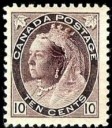
In our last article we discussed what perforations are. If you remember, perforations are the tiny punched out holes that permit us to tear our stamps from a stamp sheet. Sometimes, two stamps may seem identical, but actually have a different perforation measure. This can mean that one of the stamps is more rare than the other and worth more money. So how do you measure the perforation of a stamp?
First of all, you absolutely need a perforation gauge. This handy and inexpensive little tool will enable you to measure your stamps effectively and relatively simply. There is a little skill involved, but with some practice you’ll be a pro in no time.


